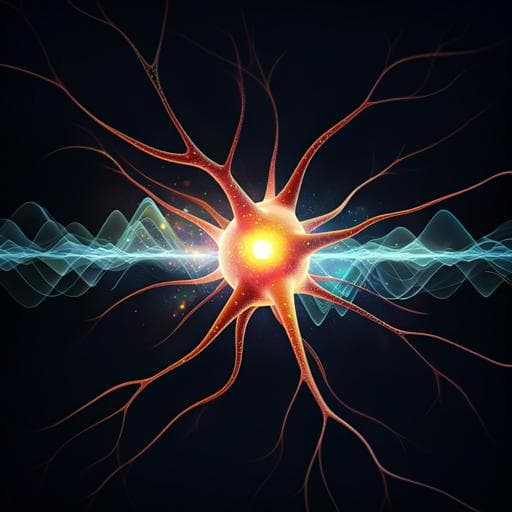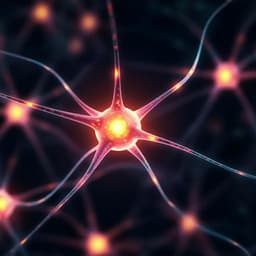
Biology
Engineering of NEMO as calcium indicators with large dynamics and high sensitivity
J. Li, Z. Shang, et al.
Discover the groundbreaking NEMO genetically encoded calcium indicators, developed by an innovative team of researchers including Jia Li and Ziwei Shang. These indicators promise rapid kinetics and impressive sensitivity, making them exceptional tools for observing neuronal activity and calcium dynamics, surpassing existing technologies.
~3 min • Beginner • English
Introduction
The study addresses the need for genetically encoded calcium indicators (GECIs) with greater peak signal-to-baseline ratio (SBR) and dynamic range (DR) to more sensitively and accurately report subtle intracellular Ca^2+ transients. Although recent efforts have improved kinetics (for example, jGCaMP8 series), increases in maximal fluorescence change have lagged behind since GECO and GCaMP6. Single-FP GECIs typically couple a fluorescent protein to a Ca^2+-sensing module (calmodulin and a target peptide such as M13/RS20). Two main architectures are used: GCaMP-like (CaM and peptide at termini of FP) and NCaMP7-like (CaM–peptide inserted within FP). mNeonGreen-based designs (NCaMP7, mNG-GECO) leverage a brighter FP but have shown relatively small in-cell dynamic ranges. This work aims to engineer mNeonGreen-based indicators that combine fast kinetics with substantially higher DR and SBR, thereby enhancing sensitivity, enabling absolute Ca^2+ quantification, and broadening applicability in cells, tissues, in vivo, and in plants.
Literature Review
Prior GECI development established ultrasensitive GCaMP6 and fast jGCaMP8 sensors, but with tradeoffs between speed and DR. Engineering strategies have targeted linker optimization and CaM–peptide–FP interfaces to modulate brightness and response. NCaMP7 and mNG-GECO, built on mNeonGreen, offer high intrinsic brightness yet limited in-cell DR. Structural similarities at sensing module insertion sites across single-FP GECIs suggest transferability of design principles. The literature also highlights the importance of photostability, pH resistance, and the potential for ratiometric or photochromic readouts to achieve absolute Ca^2+ measurements (for example, iPEAQ).
Methodology
Engineering and screening: The authors engineered a series of mNeonGreen-based NEMO constructs by introducing amino acid substitutions into NCaMP7 and modifying linkers/interfaces between CaM, M13, and FP, following known GECI design strategies. Variants (including NEMO, NEMOm, NEMOc, NEMOf, NEMOb, NEMOs) were expressed in HEK293 cells. Basal fluorescence (F0), minimal fluorescence (Fmin) following ER Ca^2+ store depletion with ionomycin (2.5 µM, 10 min) and thapsigargin (1 µM), and maximal fluorescence (Fmax) via SOCE triggered by 100 mM extracellular Ca^2+ were measured to calculate DR = (Fmax − Fmin)/Fmin. Imaging exposure adjustments prevented detector saturation, with scaling to F0.
Brightness normalization: A P2A bicistronic vector coexpressed mKate and GECIs to estimate basal brightness (FGECI/FmKate) using YFP/GFP filter sets.
In vitro characterization: Purified proteins underwent Ca^2+ titrations using Ca-EGTA/EGTA buffers; fluorescence was read on microplate readers, and Kd and Hill coefficients fit with Hill functions. Kinetics (koff) were measured by rapid mixing assays. Spectral properties (excitation/emission/absorption), quantum yields, and chromophore extinction coefficients were determined across pH, along with two-photon excitation cross-sections. Mechanistic analysis partitioned anionic vs neutral chromophore contributions to DR.
Photostability: Widefield photobleaching under varying illumination powers compared NEMO vs GCaMP6m and mNeonGreen; the effect of strong illumination on basal NEMO fluorescence was quantified.
Cellular assays: HEK293 cells were stimulated with carbachol (10 µM) to evoke Ca^2+ oscillations and with thapsigargin to induce store release and SOCE. Opto-CRAC coexpression enabled graded Ca^2+ influx via controlled photoactivation to assess sensitivity/resolution. Cells expressing the insect fructose receptor BmGr-9 tested detection of weak Ca^2+ signals.
Ratiometric and photochromic quantification: NEMOs were excited at 488 nm and 405 nm to obtain intensiometric and ratiometric signals (F488/F405). Photochromism-enabled iPEAQ used brief 405-nm pulses superimposed on 488 nm to derive photochromism contrast ((F0 − F∞)/F0) and, with in vitro calibration curves, compute absolute intracellular [Ca^2+].
Neuronal assays ex vivo/in vitro: Dissociated rat hippocampal neurons were subjected to field stimulation (1–180 Hz) under confocal/spinning disk imaging; responses (ΔF/F0), kinetics, and SNR were quantified. In acute mouse cortical slices, whole-cell current-clamp recordings elicited AP trains while two-photon imaging recorded GECI responses, assessing peak SBR vs frequency and half-decay times.
In vivo imaging: Two-photon microscopy in mouse primary visual cortex (V1) measured responses to drifting gratings. To directly compare with GCaMP6, excitation at 920 nm was used (optimal for GCaMP; NEMO optimal ~980 nm). Peak ΔF/F0, SNR, half-decay time, and orientation/direction selectivity were analyzed.
Fiber photometry: In mouse corpus striatum, ratiometric fiber photometry (F410 and F470) recorded responses to tail pinch in animals expressing NEMOs or GCaMP6f, comparing peak responses and distributions.
Plant imaging: NEMOm fused to PDLP1 reported Ca^2+ oscillations near plasmodesmata in Arabidopsis leaves using Airyscan confocal microscopy.
Plasmid construction, bacterial expression/purification, optical instrumentation parameters, calibration equations, and data analysis pipelines (MATLAB/Prism) are described in detail in the Methods.
Key Findings
- Large dynamic range and sensitivity: In-cellulo DRs of NEMOs and NEMOb were 102.3 ± 4.0 and 128.8 ± 3.1, respectively, at least 4.5× higher than GCaMP6m or NCaMP7. NEMOm and NEMOc achieved DRs of 240.7 ± 7.6 and 422.2 ± 15.3, representing 9.5–25.7× improvements.
- In vitro properties: Except for NEMOb, four NEMO sensors exhibited DRs ≥ ~100-fold. Representative Ca^2+ affinities (Kd, nM; Hill): NEMOs 156 ± 4 (Hill 2.7 ± 0.2); NEMOb 141 ± 1 (2.6 ± 0.1); NEMO 528 ± 17 (3.2 ± 0.3); NEMOc 557 ± 16 (3.8 ± 0.4); NEMOm 249 ± 18 (3.3 ± 0.1).
- Mechanism of high DR: NEMOc’s Ca^2+-dependent brightening stems from increased fraction and brightness of the anionic chromophore. Apo anionic brightness was very low (0.22 ± 0.01 mM^−1 cm^2), ~1/6 of NCaMP7 and ~1/5 of GCaMP6m, while Ca^2+-saturated anionic brightness (64.26 ± 2.67 mM^−1 cm^2) was ~3× GCaMP6m.
- Photostability and illumination tolerance: NEMOs outperformed GCaMP6m and mNeonGreen in photostability, withstanding ~40× higher illumination (1.52 mW vs 0.04 mW) without appreciable bleaching; stronger illumination boosted NEMOm’s basal fluorescence >60-fold.
- Nonexcitable cells (HEK293): For CCh-induced Ca^2+ transients, NEMOb and NEMOs had peak SBRs ≥3× higher than GCaMP6m, jGCaMP8f, and NCaMP7. NEMOm (101.9 ± 6.6), NEMOc (112.0 ± 9.8), and NEMOf (194.3 ± 7.7) showed 13–25× higher SBR than GCaMP6m. For TG-induced release and SOCE, NEMOs’ peak SBRs were ≥5× NCaMP7. NEMOs robustly detected weak BmGr-9-evoked Ca^2+ signals surpassing GCaMP6s (P = 2.52 × 10^−5).
- Resolution of graded signals: With Opto-CRAC, NEMOm showed significant stepwise increases vs stimulation duration (1,000 ms vs 300 ms, P = 4.3 × 10^−7), outperforming GCaMP6m. NEMOm/NEMOs resolved more extracellular Ca^2+ gradients than GCaMP6m/NCaMP7, with markedly higher SNR across conditions (multiple P values down to 10^−37).
- Ratiometric and absolute [Ca^2+]: NEMOs’ F405 decreased with Ca^2+, and F490/F405 ratiometry provided 3.4× higher in vitro DR than intensiometry. In-cell ratiometric DRs exceeded intensiometric (P = 0.0002). Photochromic iPEAQ enabled absolute [Ca^2+] quantification during CCh responses.
- Neuronal performance in vitro: All NEMOs detected single APs with peak SBR ~2× GCaMP6s/6f. NEMOf matched or exceeded GCaMP6f kinetics and clearly resolved 5–10 Hz stimulation, with larger amplitudes. At higher frequencies (20–180 Hz), NEMOf responses were 5–22.7× higher than GCaMP6f with significantly higher SNR (P values 10^−5 to 10^−8), and responses remained linear without saturation up to 180 Hz.
- Brain slices: Under whole-cell patch in mouse cortex, NEMO responses at ≥50 Hz were significantly larger than GCaMP6, with NEMOf the fastest (e.g., vs GCaMP6s at 50 Hz, P = 3.5 × 10^−4; at 100 Hz, P = 1.4 × 10^−5).
- In vivo two-photon imaging (V1): Using 920 nm excitation (suboptimal for NEMO), NEMOf had half-decay 409 ± 54 ms, comparable to GCaMP6f (482 ± 48 ms). The cumulative peak ΔF/F0 distributions for NEMOm and NEMOs were right-shifted vs GCaMP6s/6f; the median NEMOs response was >4× and >7× stronger than GCaMP6s and GCaMP6f, respectively. NEMOf median ΔF/F0 = 0.80 vs GCaMP6f 0.44 (P = 0.0202). NEMOs showed better SNR and basal fluorescence comparable to GCaMP6s under GCaMP-optimized conditions; at 980 nm excitation, NEMOf retained large SBR and achieved higher SNR.
- Fiber photometry (striatal neurons): Despite non-optimal excitation wavelengths for NEMO, median peak ratiometric responses to tail pinch with NEMOs were ~3× GCaMP6f (P = 4.57 × 10^−10; distribution P = 1.6 × 10^−22).
- Plant imaging: NEMOm-PDLP1 reported subcellular Ca^2+ oscillations near plasmodesmata in Arabidopsis leaves, demonstrating utility beyond mammalian systems.
Discussion
The NEMO suite addresses limitations of existing GECIs by combining high dynamic range with fast kinetics, yielding substantially higher SBR and SNR across diverse preparations, from HEK293 cells to neurons in vitro, ex vivo, and in vivo. Mechanistically, enhanced DR arises from both suppressed apo anionic fluorescence and increased brightness upon Ca^2+ binding. Superior photostability allows stronger illumination to offset lower basal brightness when needed. Ratiometric excitation (F490/F405) and photochromism-enabled iPEAQ extend NEMOs into quantitative biosensors for absolute [Ca^2+] measurements, overcoming a key drawback of intensiometric sensors. In neuronal applications, NEMOf delivers rapid responses rivaling or surpassing fast GECIs while maintaining large DR, supporting detection of single APs and high-frequency activity without saturation. In vivo imaging reveals stronger and more robust responses than GCaMP6 variants even under non-optimal excitation, suggesting further gains with optimized wavelengths. Collectively, the data validate NEMOs as sensitive, versatile indicators that improve resolution of Ca^2+ signaling dynamics and broaden experimental capabilities, including multiplexing with cyan fluorescence and applications in plant biology.
Conclusion
The authors present NEMO, a toolkit of mNeonGreen-based GECIs engineered to provide large dynamic ranges (>100-fold for several variants), high sensitivity, and fast kinetics. NEMOs outperform state-of-the-art GCaMP6 and NCaMP7 indicators in SBR/SNR, detect single action potentials with higher fidelity, maintain linear responses up to high stimulation frequencies, and enable absolute Ca^2+ quantification via ratiometric and photochromic strategies. They exhibit superior photostability and compatibility with strong illumination, making them suitable for in vivo and subcellular imaging in mammals and plants. Future work could optimize excitation conditions (e.g., 980 nm two-photon), further investigate the cellular factors enhancing in-cell DR (macromolecular crowding/reducing environment), refine background correction methods for DR estimation, and extend NEMO colors or targeting for multiplexed and organelle-specific Ca^2+ sensing.
Limitations
- Dynamic range estimation caveat: Very large in-cell DRs (100–300) require Fmin close to background; detector saturation and imperfect background subtraction may overestimate DR.
- Basal fluorescence: Several NEMOs have lower basal brightness than GCaMP6m/NCaMP7, potentially impacting visibility without stronger illumination.
- Excitation wavelength mismatch in vivo: Comparisons often used 920 nm (optimal for GCaMP, suboptimal for NEMO), potentially underrepresenting NEMO performance; conversely, near-UV (405–410 nm) excitation used for ratiometry/photochromism can reduce DR.
- Whole-cell patch effects: Intracellular dilution/perturbation under patch clamp may reduce GECI signal amplitudes, complicating quantitative comparisons.
- Generalizability: While robust across tested systems, performance in additional cell types, deeper brain regions, or long-term chronic imaging conditions requires further validation.
Related Publications
Explore these studies to deepen your understanding of the subject.







